Technics SU-R1000 Review – Start your engines!
The latest integrated amp from Technics is both a flagship and a technological statement. EdSef/ey swots up on his jargon. Read our Technics SU-R1000 Review.
Such has been the – largely [ justifiable – excitement f * over the return of Technics turntables that it can be all too easy to overlook the fact that the overall product launches of the brand have been a balanced affair. As well as its headline-grabbing vinyl spinners, the company has focussed on the creation of a comprehensive range of source equipment and amplification. This is headed up by the Reference Class of components that, up to this point, has used a pre/ power combination. The SU-R1000 joins to give an integrated option Calling it sophisticated is an understatement akin to describing a Naga Viper chili as: “a little piquant”. From the volume control to the speaker terminals, Technics hasn’t wasted an opportunity to go its own way in engineering terms. In essence, it’s a digital amplifier that uses pulse width modulation (although Technics is not keen to describe this as Class D) through a completely bespoke module. This is coupled to the output via FETs in the classic Technics tradition and generates a solid if not spectacular 150W into 8ohm, doubling into four.
This module is fed by an analogue- to-digital system designed to ensure that the signal sent to the module is both clock synced and free from jitter. A system the company has dubbed JENO Engine works to strip jitter from the signal, ensuring it is not amplified (and thus exacerbated). This runs alongside a system called ADCT (Active Distortion Cancelling Technology). This examines the signal before it enters the module and again after, so that anything erroneous is removed while applying the gain control to the amplified signal.
As this circuit will always redigitise all audio being sent to it, Technics has taken the opportunity to be no less ambitious with the phono stage. This supports both moving-magnet and coil designs (with the option of running fully balanced for the latter), but where it differs from anything else I can remember testing is that the DSP used as part of the digitising process compares the output of your cartridge against a notional ideal. By using a supplied test record, you can have correction applied on the fly as part of playback. For a few people, the idea that your glorious analogue signal is being turned into ones and zeroes will be a step too far, but it is unquestionably clever.
DETAILS
| PRODUCT | TechnicsSU-R1OOO |
| TYPE | Integrated amplifier |
| WEIGHT | 22.8kg |
| DIMENSIONS(WxHxD) | 430x191x459mm |
| FEATURES | Quoted power output: 2x150W (8ohm) Analogue inputs: 2x RCA; balanced XLR; RCA MM/MC phono; balanced XLR MC phono Digital inputs: 2x optical; 2x coaxial; 2×088-8 |
| DISTRIBUTOR | Panasonic UK |
| TELEPHONE | 03332228777 |
| WEBSITE | technics.com/uk |
| ORIGIN | Japan |
The phono stage is joined by two RCA inputs and another XLR. There is
The SU-R1OOO shows an unflappable ability across its broad range of connections
then a digital board featuring two optical, two coaxial and two USB inputs, although I’m at a loss as to exactly what purpose Technics envisages for the second one of those. Sample rate handing for the USBs is quoted as being 384kHz PCM and DSD256 with the coaxial and optical handling being correspondingly lower. Connectivity is rounded off with switchable A/B speaker terminals, a tape loop and both pre out and power amp inputs.
All this is placed inside a chassis that adheres to the high rigidity principles and that is beautifully assembled. The chassis forgoes the sort of metal thicknesses associated with an armoured vehicle, but the way it’s constructed borders on the obsessive. The design is a combination of classic Technics models of old and features from current designs. The decision to place the controls above the VU meters rather than around them is slightly less visually elegant, but does make it straightforward to use. However, it’s rather less satisfying in terms of control and setup. The enormous amount of functionality is effectively menu driven and viewed via the small front-panel display. This means that great tracts of the manual are given over to menu trees. It never feels intuitive to use and precludes you experimenting as much with features as Technics might hope. In more positive news, the remote handset, while fairly prosaic, is easy to use and works well.
Sound quality
Connecting the Technics to Kudos’ Titan 505 standmount (HFC 451) and a Roon Nucleus (HFC 439) via USB, it does two important things. The first is that none of the extensive technology that has gone into its construction is directly audible. You don’t sit there thinking: “Yup, that’s the JENO Engine,” instead you sit listening to the amp on its own virtues. This feeds neatly into the second noticeable aspect, which is that – despite the new technology at work – it still sounds like a Technics.
Consequently The Woman You Want by Eliza Shaddad is utterly effortless in how it’s presented. Shaddad sounds confident, believably proportioned and gloriously vivid. The album is mastered to show off her considerable vocal talent and the Technics delivers the intent with real assurance. Absolutely integral to everything it does is that it never sounds forced or strained. Even
Costing £2,000 less, Yamaha’s A-S3200 (HFC464) lacks digital inputs, but the comparison is still valid. Despite all the differences in how they work, they have many sonic similarities, with a rich and effortless presentation from both. The Yamaha is more rhythmically engaging, has a better selection of analogue inputs and is more attractive. The SU-R1000 fires back with the presence of its excellent digital board and that superb phono stage. Choosing between them will come down in part-to your source equipment.
The way the chassis is constructed borders on the obsessive
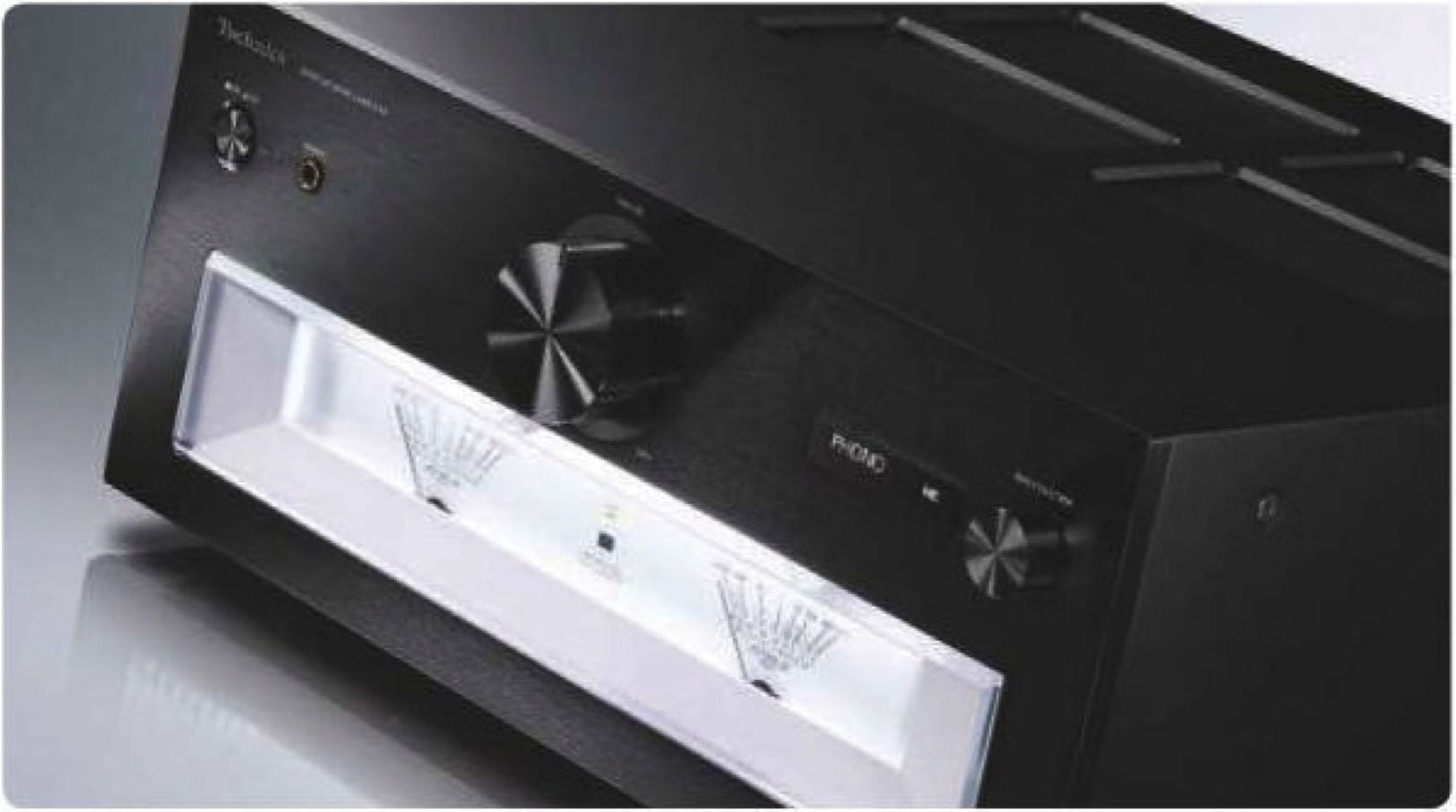
during the vast crescendo of In the Morning (Grandmother Song) it feels utterly unburstable.
The Technics also has enormous reserves of scale. The Cinematic Orchestra’s A Caged Bird/Imitations Of Life becomes a vast and immersive performance combining seismic levels of low end with an open and airy treble performance. Within this space, instrumental tonality and Roots Manuva’s distinctive vocal turn sound utterly believable. No less usefully, it’s hard to provoke, delivering the benefits of a higher quality recording without slaughtering less than pristine ones.
The caveat to this is that ‘sounding like a Technics’ means the SU-R1000 never feels like the liveliest amp going. Remind Me by Emily King is tonally superb, suitably potent and gloriously open, but where some take that rich synth line and really groove with it, the Technics is a little more relaxed.
However, it has some virtues that are not only beyond most integrated phono stages, but also many standalone ones as well. Using the AVID Ingenium (HFC 379) and SME M2-9 arm together with the Sumiko Songbird (HFC 465), this is a seriously capable performer. Even before the calibration is run, it delivers the same excellent tonality and deep controlled bass as the other inputs coupled to a negligible noise floor. Having run the additional setup, this is complemented by an outstanding perception of stereo image and three dimensionality.
What’s important about this is that none of the tremendous sophistication that goes into the phono stage working in this manner is an audible part of what it does. If you can bring yourself to relax about the fact that what you are hearing has been converted from analogue to digital, studied for its jitter quotient and compared in amplified and unamplified form, it’s hard to argue that it’s an uncanny take on the constituent parts of the turntable itself.
Conclusion
This amp is going to win itself a lot of friends, mainly thanks to the sheer, unflappable ability it demonstrates across its considerable range of connections. The SU-R1000 is not a shock-and-awe style device which may confuse a few people looking at the panoply of technology that it so clearly incorporates. Instead it’s a continuation of a longstanding design tradition of unforced musicality, but one that uses 21st-century technology to deliver it. If you’re looking for an immensely talented all-rounder, this is a very good place to start
When you purchase through links on our site, I may earn an affiliate commission. Here’s how it works.
MEASUREMENTS
I started testing the sample of the Technics SU-R1000 that KM had auditioned, serial number GJ1001007, with my Audio Precision SYS2722 system (see the January 2008 As We See It1). However, while I was performing the small-signal tests, the amplifier turned itself off. The temperature of the black grilles on the amplifier’s top panel, which cover the internal heatsinks, was 127.9°F/52.9°C. I wondered if the amplifier had over-heated. According to the manual, “one of the unit’s safety devices may have been activated. Press the unit on/off button to the Off position. If the unit does not switch to standby, disconnect the AC power supply cord, wait for at least 3 minutes, then reconnect it.”
I followed these instructions, waiting 20 minutes instead of 3 minutes to allow the amplifier to cool down. However, when I turned the amplifier on, it turned itself off and would not turn itself on again. Bill Voss, Technics US’s business development manager, had a new sample, serial number GJ1DA001010, shipped to me so that I could continue with the measurements.
As the SU-R1000 has an output stage operating in a mode that resembles class-D (although Technics says that it’s not class-D), I inserted an Audio Precision auxiliary AUX-0025 passive low-pass filter between the test load and the Audio Precision analyzer. This filter eliminates RF noise that could drive its input circuitry into slew-rate limiting. I used it for all the loudspeaker output tests other than frequency response. After two hours of operation, the temperature of the black grilles was lower than that of the first sample, at 114.2°F (45.7°C).
I looked first at the Technics’s performance via its balanced and single-ended line inputs. The SU-R1000 preserved absolute polarity at all outputs. The volume control operated in accurate 0.5dB steps, and the maximum gain at the loudspeaker outputs was 46.5dB for both types of inputs. (The optional 20dB attenuation was bypassed for this measurement.) At the preamplifier output, the gain was 16.7dB and at the headphone output it was 33.1dB. The Technics’s power amplifier can be accessed separately. It offered a fixed gain of 30.1dB. The input impedance at the unbalanced line inputs was 50k ohms at 20Hz and 1kHz, with an inconsequential drop to 37k ohms at 20kHz. The balanced input impedance was 92k ohms at low and middle frequencies, dropping to 64k ohms at the top of the audioband. The input impedance at the single-ended power amplifier input jacks was 50k ohms at 20Hz, 65k ohms at 1kHz, and 42k ohms at 20kHz.
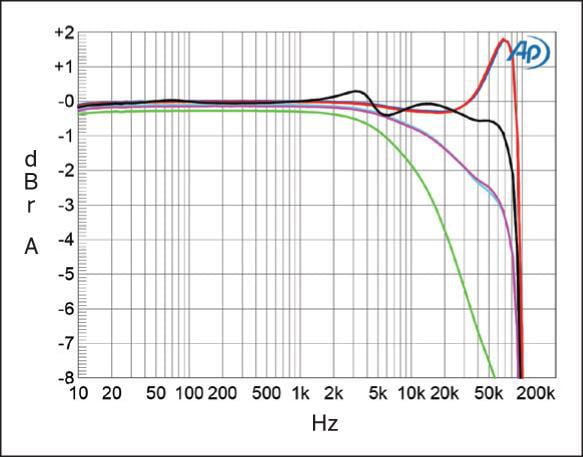
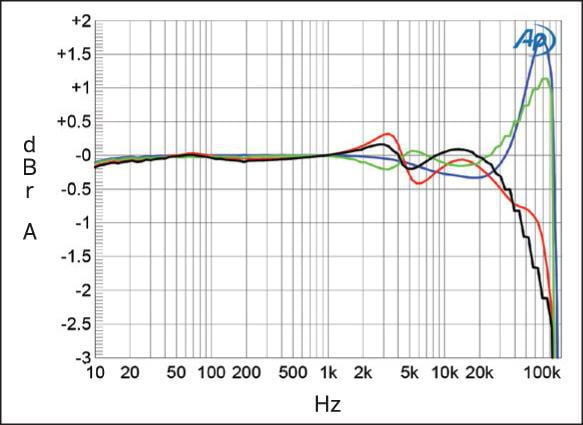
The amplifier’s output impedance at the headphone output was a relatively high 100 ohms. At the preamplifier output, it ranged from 728 ohms at 20Hz to 706 ohms at 20kHz. The output impedance at the loudspeaker terminals was 0.09 ohm at 20Hz and 1kHz rising to 0.7 ohm at 20kHz. (These figures include the series impedance of 6′ of spaced-pair loudspeaker cable.) The modulation of the amplifier’s frequency response due to the Ohm’s law interaction between this source impedance and the impedance of my standard simulated loudspeaker2 was therefore a low ±0.25dB (fig.1, gray trace). The response into an 8 ohm resistive load (fig.1, blue and red traces) peaked by almost 2dB at 70kHz but rolled off rapidly above that frequency. (The analog inputs appear to be digitized with a sample rate of 192kHz.) With a resistive 4 ohm load (cyan and magenta traces), the output started to roll off slightly in the top audio octave, reaching –3dB at 61kHz. Into 2 ohms (green trace), the output was down by 3dB at 18kHz. This graph was taken with the volume control set to its maximum. The excellent channel matching was preserved at lower settings of the control.
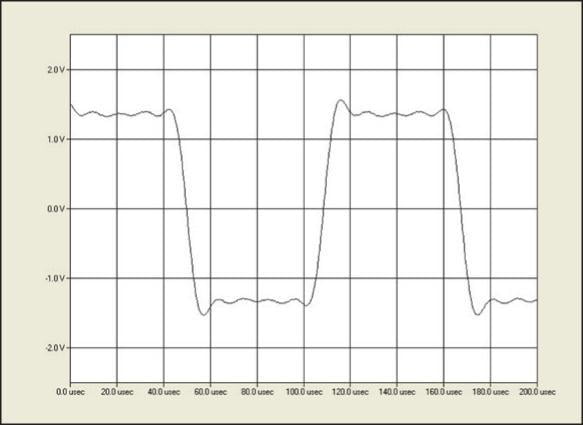
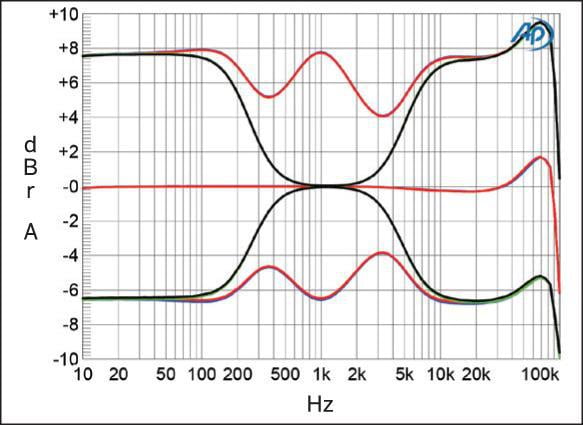
The SU-R1000 has a unique LAPC function, which is intended to compensate for the changes in a loudspeaker’s impedance with frequency. I investigated this by connecting an 8 ohm resistor to the left channel and my simulated loudspeaker to the right. (I don’t have two simulated loudspeakers, and I assumed that LAPC would be set differently for the two channels.) I selected LAPC with the remote control, waited for the amplifier to finish measuring the load impedances, and after it said that it was finished, I measured the SU-R1000’s frequency response with and without LAPC. The blue and red traces in fig.2 were taken without LAPC and are identical to the blue and gray traces in fig.1, plotted with an expanded scale. The green and gray traces respectively show the responses of the 8 ohm resistor and the simulated loudspeaker with LAPC. The variations in response have been reduced in amplitude but not eliminated. I suspect that the SU-R1000 is applying the same LAPC compensation to both channels; in real-world use of course, the channels would be connected to identical loudspeakers.
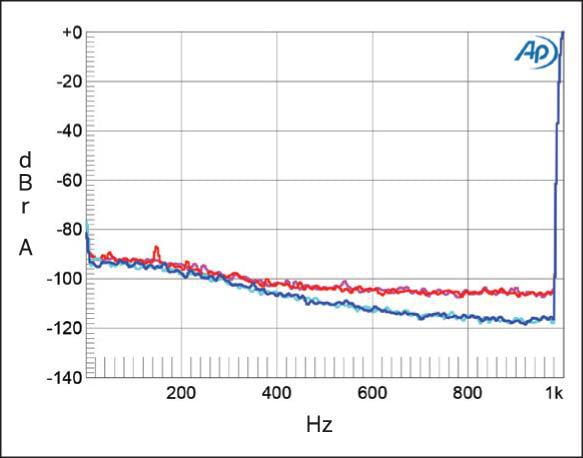
The peak at 70kHz with 8 ohms in fig.1 correlates with the slight overshoot with the Technics’s reproduction of a 10kHz squarewave’s leading edges into that load (fig.3). There is also some ringing and a slight overshoot with the waveform’s trailing edges, both of which will be due to the antialiasing filter of the amplifier’s A/D converter. There are three tone controls: bass, midrange, and treble. These offered a maximum boost of 7.8dB and a maximum cut of 6.3dB (fig.3, blue and red traces). The gray and green traces were taken with the midrange control operating but set to “0.” You can see that this control covers the region between 300Hz and 3kHz.
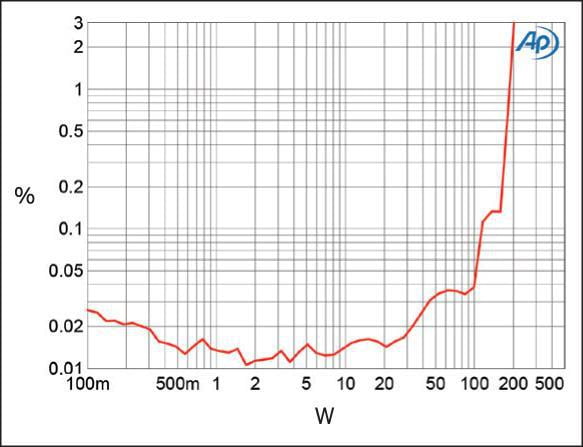
Channel separation was excellent, at >100dB in both directions below 2.5kHz and still 67dB at the top of the audioband. Without the auxiliary low-pass filter, 316mV of ultrasonic noise was present at the loudspeaker outputs. With the filter, the Technics’s unweighted, wideband signal/noise ratio, taken with the unbalanced line inputs shorted to ground but the volume control set to its maximum, was 48.2dB ref. 2.83V into 8 ohms in both channels. (Note that the filter is not designed to remove all ultrasonic noise.) This ratio improved to 71dB when the measurement bandwidth was restricted to the audioband, and to 74.4dB when A-weighted. Spuriae at the supply frequency of 60Hz and its harmonics were absent in the amplifier’s output, but the spectrum of the random noise background varied with the setting of the volume control. The magenta and red traces in fig.5 were taken with the volume control set to the maximum. Reducing the volume to “–20.0” lowered the levels of the random noise at higher frequencies in both channels (cyan and blue traces). However, even at the maximum volume control setting the noise is relatively low in level.
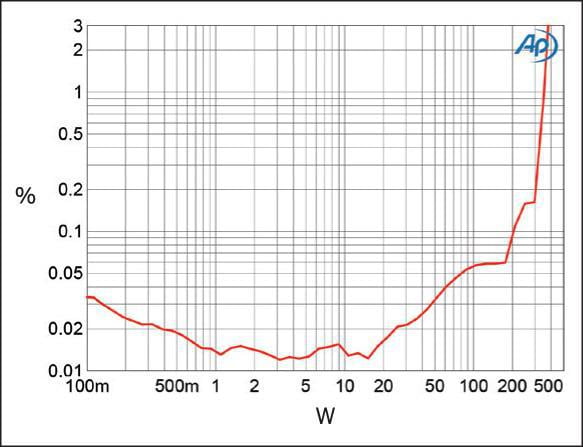
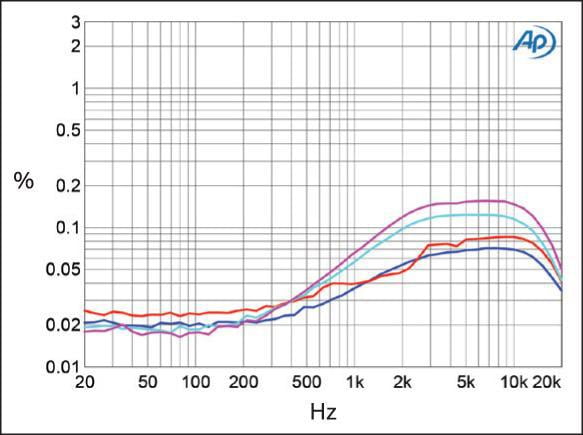
With both channels driven, the SU-R1000 exceeded its specified maximum power into 8 ohms of 150Wpc (21.76dBW), delivering 190Wpc at 1% THD+noise (22.8dBW, fig.6). Into 4 ohms, the Technics clipped at 355Wpc (22.5dBW, fig.7), which is still higher than the specified power into that load. I didn’t test clipping power into 2 ohms, as the amplifier isn’t specified into that load. The distortion is low at low powers, so I examined how the THD+N varied with frequency at 20V, which is equivalent to 50W into 8 ohms and 100W into 4 ohms. The results are shown in fig.7. The distortion is very similar into both impedances, at <0.03%. It does rise in the top two octaves, however—more into 4 ohms (cyan and magenta traces) than into 8 ohms (blue and red traces).
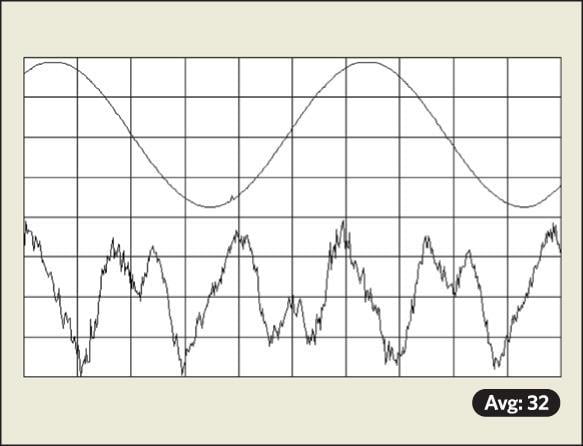
The distortion was predominantly the third harmonic (fig.9), but at low and moderate powers it lay below the analog noisefloor. The third harmonic can just be seen at –89dB (0.003%) when the Technics drove a 50Hz tone at 100Wpc into 4 ohms (fig.10) with the volume control set to –12dB. I got somewhat different results in the two channels when the SU-R1000 drove an equal mix of 19 and 20kHz tones at 50W peak into 8 ohms (fig.11). The second-order difference product at 1kHz is very low in both channels, at close to –110dB (0.0003%), but more high-order products are present in the right channel (red trace) than the left (blue). I repeated this test with different signal and speaker cables and with the analyzer input channels swapped but got the same result each time. It is fair to note that other than those at 17kHz, 18kHz, 21kHz, and 22kHz, all the intermodulation products lay at or below –84dB (0.006%) in both channels.
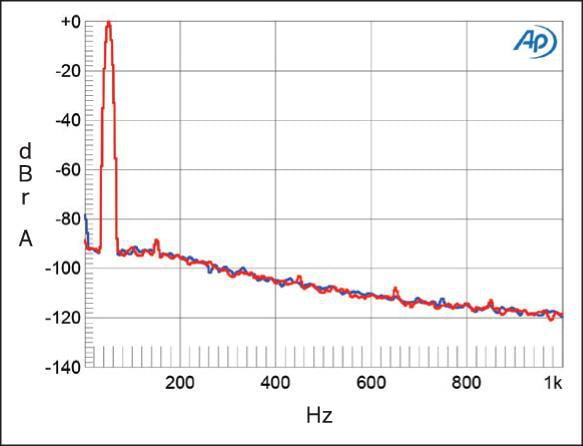
The Technics SU-R1000 offered excellent measured performance from its line inputs. My testing of its digital and phono inputs will be included in next month’s Follow-Up section.
—John Atkinson
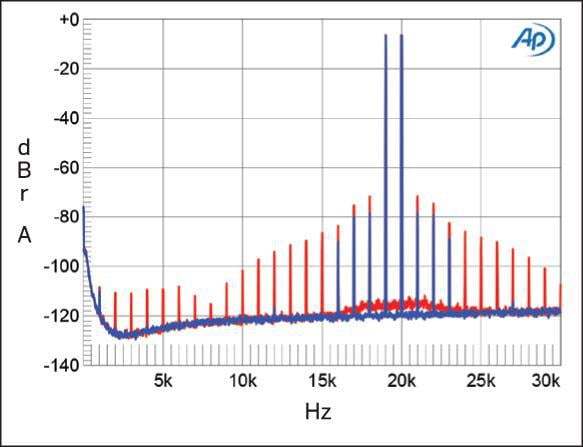

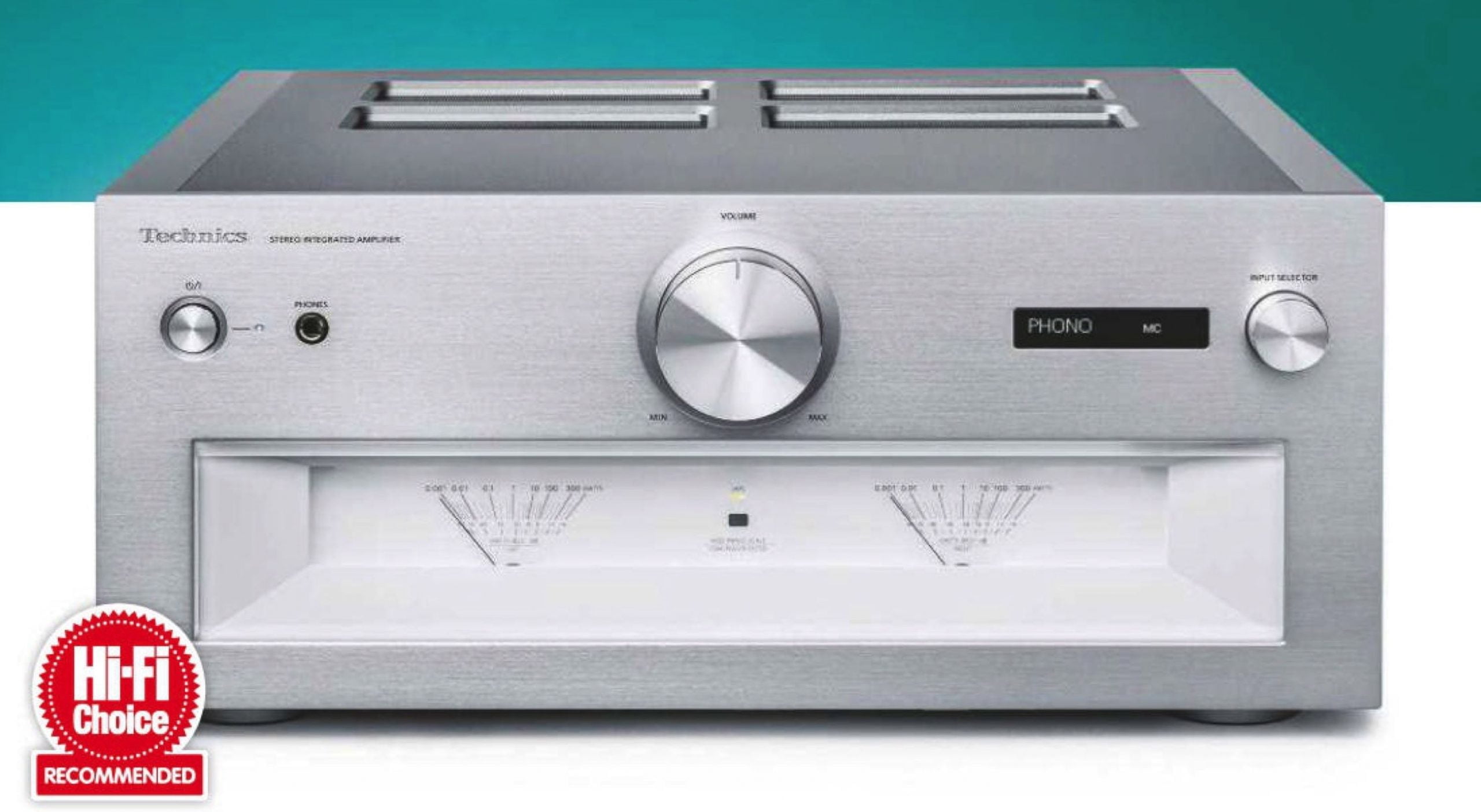





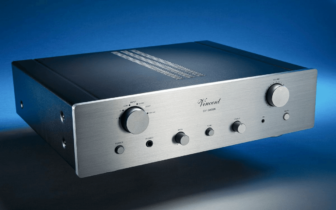
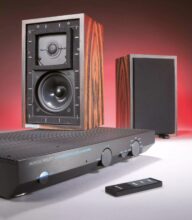
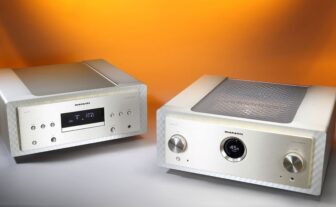
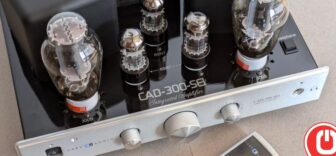
The set up is so simple, it makes me wonder if you actually did a ’hands on review’ of the SU-R1000!